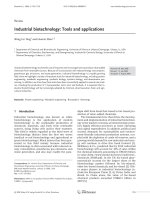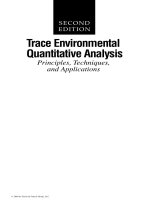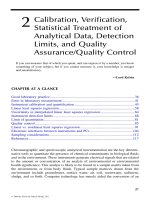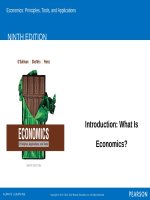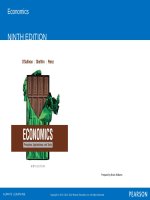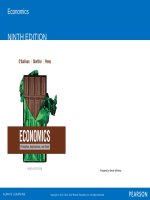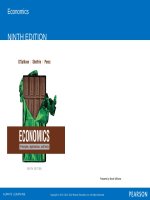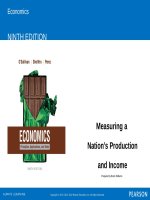Economics principles tools and applications 9th by sullivan sheffrin perez chapter 31
Bạn đang xem bản rút gọn của tài liệu. Xem và tải ngay bản đầy đủ của tài liệu tại đây (621.56 KB, 26 trang )
Economics
NINTH EDITION
Chapter 31
Insert Cover Picture
External Costs
and
Environmental Policy
Copyright © 2015, 2012, 2009 Pearson Education, Inc. All Rights Reserved
Learning Objectives
31.1 Use the marginal principle to describe the optimum level of pollution.
31.2 Describe the role of taxation in promoting efficient environmental policy.
31.3 Explain the superiority of taxation over traditional regulation.
31.4 Describe the virtues of marketable pollution permits and the factors that determine their price.
31.5 List three external costs associated with automobiles.
Copyright © 2015, 2012, 2009 Pearson Education, Inc. All Rights Reserved
31.1 THE OPTIMAL LEVEL OF POLLUTION (1 of 4)
In a recent report, the IPCC presents three key Concerns
Observed Changes in Climate
Causes of Change
Projected Climate Change and its Impacts
Copyright © 2015, 2012, 2009 Pearson Education, Inc. All Rights Reserved
31.1 THE OPTIMAL LEVEL OF POLLUTION (2 of 4)
Using the Marginal Principle
MARGINAL PRINCIPLE
Increase the level of an activity as long as its marginal benefit exceeds its marginal cost. Choose the level at which the marginal benefit equals the
marginal cost.
From society’s perspective, there are many benefits from pollution abatement:
Better health.
Increased enjoyment of the natural environment.
Lower production costs.
Copyright © 2015, 2012, 2009 Pearson Education, Inc. All Rights Reserved
31.1 THE OPTIMAL LEVEL OF POLLUTION (3 of 4)
Example: The Optimal Level of Water
Pollution
The efficient level of pollution abatement, where marginal benefit
equals marginal cost, is 300 tons (200 tons of waste).
If the polluter has property rights we start with zero abatement and
the other party pays for 300 tons of abatement.
If the other party has property rights, we start with zero abatement
and the polluter pays to increase pollution to 200 tons of waste.
Copyright © 2015, 2012, 2009 Pearson Education, Inc. All Rights Reserved
31.1 THE OPTIMAL LEVEL OF POLLUTION (3 of 3)
Coase Bargaining
Coase bargaining solution, named after economist Ronald Coase, applies to a situation when there is a small number of affected parties, and the transactions
costs of bargaining are relatively low.
We can illustrate the bargaining solution with our example of a lake shared by a steel mill and a fishing firm. If the steel mill has the property rights to the lake, it
can dump waste into the lake.
The fishing firm benefits from abatement, and would be willing to pay the mill to reduce pollution. For the first ton of abatement, the fishing firm is willing to pay
$21, the cost of abating the first ton is only $3, and the two parties can cut a deal.
If they split the difference between the benefit and the cost, the fishing firm will pay $12 to the mill for one ton of abatement, and both will be better off. The
fishing firm pays $12 to get $21 in additional fish, while the mill gets $12 to incur an abatement cost of $3.
Copyright © 2015, 2012, 2009 Pearson Education, Inc. All Rights Reserved
APPLICATION 1
REDUCING METHANE EMISSIONS
APPLYING THE CONCEPTS #1: How do we determine the optimum level of pollution?
Methane is one of the greenhouse gases that contributes to global warming.
It is released into the atmosphere from landfills, natural gas systems, coal mining, and livestock management.
Pollution abatement requires capturing methane before it is released and using it to generate electricity.
•Marginal cost is $10 per ton up to 36 million ton
•Rising to $150 per ton up to 69 million tons
The optimal level of abatement is where the marginal benefit equals the marginal cost
Copyright © 2015, 2012, 2009 Pearson Education, Inc. All Rights Reserved
31.2 TAXING POLLUTION (1 of 6)
Private cost of production
The production cost borne by a producer, which typically includes the costs of labor, capital, and materials.
External cost of production
A cost incurred by someone other than the producer.
Social cost of production
Private cost plus external cost.
Pollution tax
A tax or charge equal to the external cost per unit of pollution.
Copyright © 2015, 2012, 2009 Pearson Education, Inc. All Rights Reserved
31.2 TAXING POLLUTION (2 of 6)
A Firm’s Response to a Pollution Tax
From the perspective of a firm subject to a pollution tax, the marginal
benefit of abatement is the $3,500 pollution tax that can be avoided
by cutting pollution by one ton.
The firm satisfies the marginal principle at point c, with six tons of
abatement, leaving two tons of SO2 discharged into the atmosphere.
Copyright © 2015, 2012, 2009 Pearson Education, Inc. All Rights Reserved
31.2 TAXING POLLUTION (3 of 6)
The Market Effects of a Pollution Tax
The production of electricity generates two major pollutants:
Sulfur dioxide. Electric power plants are responsible for about two-thirds of SO2 emissions. As we saw earlier in the chapter, the marginal damage from SO2
is $3,500 per ton, so that’s the appropriate pollution tax.
Nitrogen oxides (NOx). Power plants are also responsible for about one-quarter of the nation’s NOx emissions, a contributing factor in acid rain and the most
important factor in urban smog. The study cited earlier in the chapter estimated that the appropriate tax for NOx is about $1,100 per ton.
Copyright © 2015, 2012, 2009 Pearson Education, Inc. All Rights Reserved
31.2 TAXING POLLUTION (4 of 6)
The pollution tax increases the cost of producing electricity,
shifting the market supply curve up.
The equilibrium moves from point a to point b.
The tax increases the equilibrium price from $64.90 to $67.60
per megawatt-hour and decreases the equilibrium quantity.
Copyright © 2015, 2012, 2009 Pearson Education, Inc. All Rights Reserved
31.2 TAXING POLLUTION (5 of 6)
Taxes on SO2 and NOx cause electricity generators to switch to
low-sulfur coal and to alternative energy sources that generate
less SO2 and NOx.
SOURCE: Based on Spencer Banzhaf, Dallas Burtraw, and Karen
Palmer, “Efficient Emission Fees in the U.S. Electricity Sector,”
Resource and Energy Economics 26 (2004): 317–341.
Copyright © 2015, 2012, 2009 Pearson Education, Inc. All Rights Reserved
APPLICATION 2
WASHING CARBON OUT OF THE AIR
APPLYING THE CONCEPTS #2: What are the possible responses to a pollution tax?
A carbon tax would reduce greenhouse emissions in several ways:
The price of gasoline would increase, causing people to drive less and buy more
energy-efficient vehicles.
The tax would increase the price of electricity, decreasing the quantity of electricity
demanded and the quantity of fossil fuels burned.
The higher price of home heating would cause people to turn down their thermostats
and improve the heating efficiency of their homes, perhaps by installing
energy-efficient windows or more insulation.
Some electricity producers would switch from coal to natural gas, which has
a lower carbon content, and thus a lower carbon tax.
Copyright © 2015, 2012, 2009 Pearson Education, Inc. All Rights Reserved
31.3 TRADITIONAL REGULATION (1 of 4)
Uniform Abatement with Permits
Consider an area with two electricity generators, firm L (for low cost) and firm H (for high cost).
Suppose that in the absence of pollution-abatement efforts, each firm would discharge five tons of pollution per hour.
The government sets a target abatement level of two tons of SO 2 per hour, divided equally between the two firms. Under this uniform abatement policy, the government will issue
four pollution permits to each firm, forcing each firm to cut pollution from five tons to four tons.
▼ TABLE 31.1
Uniform Reduction versus Pollution Tax
Abatement Cost
Marginal
Uniform
Pollution Tax =
Abatement Cost
Abatement Policy
$3,000 per Ton
Low-Cost Firm
$2,000
$2,000
$4,000
High-Cost Firm
$5,000
$5,000
$
$7,000
$4,000
Total
Copyright © 2015, 2012, 2009 Pearson Education, Inc. All Rights Reserved
0
31.3 TRADITIONAL REGULATION (2 of 4)
Command and Control
The problem with this approach is that the mandated abatement technology—the control part of the policy—is unlikely to be the most efficient
technology for two reasons:
The regulatory policy specifies a single abatement technology for all firms. Because the producers of a polluting good often use different materials and production
techniques, an abatement technology that is efficient for one firm may be inefficient for others.
The regulatory policy decreases the incentives to develop more efficient abatement technologies. The command part of the policy specifies a maximum volume of
waste for each firm, so there is no incentive to cut the volume of waste below the maximum allowed.
Copyright © 2015, 2012, 2009 Pearson Education, Inc. All Rights Reserved
31.3 TRADITIONAL REGULATION (3 of 4)
Market Effects of Pollution Regulations
How do the market effects of pollution regulation compare to the effects of a pollution tax?
Recall that the uniform abatement policy achieves the same reduction in pollution at a higher cost because it doesn’t exploit differences in abatement costs
across firms.
In addition, the control part of command and control may lead to relatively costly abatement techniques because there’s no incentive to develop better ones.
This will cause the supply curve for the polluting good to shift upward by a larger amount than it would with a tax.
A larger supply shift causes a larger increase in the equilibrium price and a larger reduction in quantity. The inefficiency of regulations is passed on to
consumers, who pay higher prices.
Copyright © 2015, 2012, 2009 Pearson Education, Inc. All Rights Reserved
31.3 TRADITIONAL REGULATION (4 of 4)
Lesson from Dear Abby: Options for Pollution Abatement
The readers of “Dear Abby”offered the following suggestions to Dreading Winter:
Buy the neighbors a catalytic add-on for the wood stove or a wood-chip gasifier for an oil furnace. In either case, there would be much less air pollution from
burning wood.
Soak a towel in water, swish it around the room, and watch the smoke disappear.
Leave a saucer of vinegar in each room to eliminate the smoke odor.
Pay your neighbors to hire a chimney sweep to clean their flue.
Seal and caulk your windows to keep the smoke outside at a cost of less than $500.
Use the $500 to purchase an air purifier for your home.
There is usually more than one way to deal with a pollution problem.
Copyright © 2015, 2012, 2009 Pearson Education, Inc. All Rights Reserved
APPLICATION 3
OPTIONS FOR REDUCING CO2 EMISSIONS FROM INTERNATIONAL SHIPPING
APPLYING THE CONCEPTS #3: What is the most efficient way to reduce pollution ?
International shipping is responsible for about 3% of global CO2 emissions, and there are many ways to reduce (abate) CO2 emissions. As a tool for comparing
the cost of alternative reduction methods, policy analysts compute the marginal abatement cost (MAC) of each method, defined as the cost per ton of CO2
abated. For low-cost methods such as propeller maintenance and weather-sensitive routing, the fuel savings cover the cost of the abatement method, so the
MAC for these methods is close to zero. For other abatement methods, the MAC are higher:
Switch from diesel to gas-powered engines: $20 per ton
Reduce speed and increase fleet size: $90 per ton
Install fixed sails and wings to tap wind power: $105 per ton
Copyright © 2015, 2012, 2009 Pearson Education, Inc. All Rights Reserved
31.4 MARKETABLE POLLUTION PERMITS (1 of 3)
Marketable pollution permits
A system under which the government picks a target pollution level for a particular area, issues just enough pollution permits to meet the pollution target,
and allows firms to buy and sell the permits; also known as a cap-and-trade system.
Copyright © 2015, 2012, 2009 Pearson Education, Inc. All Rights Reserved
31.4 MARKETABLE POLLUTION PERMITS (2 of 3)
Voluntary Exchange and Marketable Permits
Making pollution permits marketable is sensible because it allows mutually beneficial exchanges between firms with different abatement costs.
PRINCIPLE OF VOLUNTARY EXCHANGE
A voluntary exchange between two people makes both people better off.
Copyright © 2015, 2012, 2009 Pearson Education, Inc. All Rights Reserved
31.4 MARKETABLE POLLUTION PERMITS (3 of 3)
Supply, Demand, and the Price of
Marketable Permits
The equilibrium price of permits is shown by the intersection of the
demand curve and the vertical supply curve.
The supply curve is vertical because each year the government
specifies a fixed number of permits.
A decrease in the number of permits shifts the supply curve to the
left, increasing the equilibrium price.
Copyright © 2015, 2012, 2009 Pearson Education, Inc. All Rights Reserved
APPLICATION 4
WEATHER AND THE PRICE OF POLLUTION PERMITS
APPLYING THE CONCEPTS #4: How is the price of pollution permits determined?
The European Climate Exchange is a market for pollution allowances issued to European Union countries under the EU cap-and-trade system
The equilibrium price is determined by supply and demand
The EU determines supply and issues the permits to energy intensive industries
Demand is based on the level of economic activity, fuel prices and the weather.
The Nordic countries shift from hydro electric to coal fired electric generation in dry years.
Copyright © 2015, 2012, 2009 Pearson Education, Inc. All Rights Reserved
31.5 EXTERNAL COSTS FROM AUTOMOBILES (1 of 2)
External Costs from Pollution
A gasoline tax of $0.68 per gallon shifts the supply curve upward
by the amount of the tax.
The equilibrium price increases by $0.40.
The tax is shifted forward onto consumers, who pay $0.40 more
per gallon, and backward onto input suppliers, who receive lower
prices for crude oil.
Copyright © 2015, 2012, 2009 Pearson Education, Inc. All Rights Reserved
31.5 EXTERNAL COSTS FROM AUTOMOBILES (2 of 2)
External Costs from Congestion
The economic approach to congestion is to internalize the external cost by imposing a tax on drivers equal to the external costs they impose on others. Modern
technology allows the efficient collection of congestion taxes. The use of congestion taxes and other time-sensitive pricing of highways is spreading.
External Costs from Collisions
In the United States, the annual cost of property damage, injuries, and deaths from traffic collisions is about $300 billion per year. About two-thirds of these
costs are incurred by the driver who causes the accident, and the other third is borne by someone else. In other words, traffic collisions have substantial
external costs. On average, the collision-related external cost of travel is about 4.4 cents per mile driven. By way of comparison, the fuel cost per mile is about
10 to 15 cents. The direct approach to internalize this externality would be to impose a tax of 4.4 cents per vehicle-mile traveled, a VMT tax. Such a tax would
improve traffic safety by reducing the number of miles driven. Alternatively, the premium for automobile insurance could be based on miles driven or a gasoline
tax could be imposed.
Copyright © 2015, 2012, 2009 Pearson Education, Inc. All Rights Reserved
APPLICATION 5
YOUNG DRIVERS AND COLLISIONS
APPLYING THE CONCEPTS #5: What is the external cost of young drivers?
A VMT tax of 4.4 cents per mile would internalize the external cost from collisions on average, but the external cost varies with the age of the driver. The
external cost per mile is 11 cents for young drivers (age less than 25 years), 3.4 cents for middle-aged drivers (age 25 to 70), and 5.4 cents for older
drivers.
A precise VMT tax would involve a higher tax rate for young drivers and generate a relatively large decrease in the miles driven by drivers with the highest
collision rates and external costs.
Copyright © 2015, 2012, 2009 Pearson Education, Inc. All Rights Reserved
